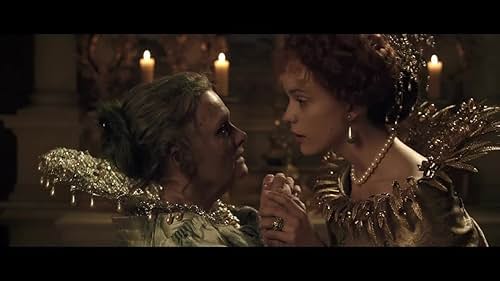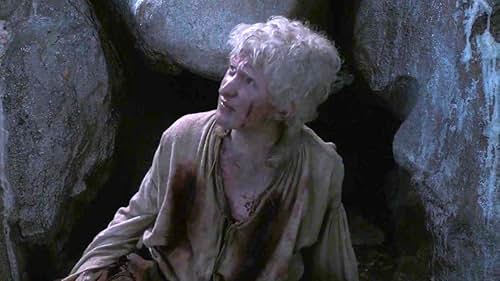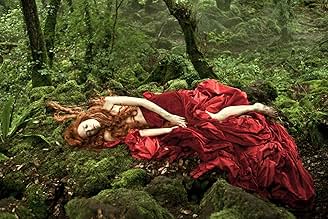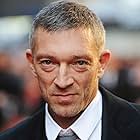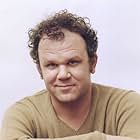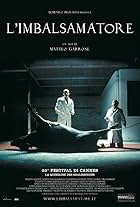From the bitter quest of the Queen of Longtrellis, to two mysterious sisters who provoke the passion of a king, to the King of Highhills obsessed with a giant Flea, these tales are inspired ... Read allFrom the bitter quest of the Queen of Longtrellis, to two mysterious sisters who provoke the passion of a king, to the King of Highhills obsessed with a giant Flea, these tales are inspired by the fairytales by Giambattista Basile.From the bitter quest of the Queen of Longtrellis, to two mysterious sisters who provoke the passion of a king, to the King of Highhills obsessed with a giant Flea, these tales are inspired by the fairytales by Giambattista Basile.
- Awards
- 21 wins & 15 nominations
Storyline
Did you know
- TriviaThe movie was based on the Pentamerone ("The Tale of Tales, or Entertainment for Little Ones"), a collection of fairy tales by 17th century Italian poet and courtier Giambattista Basile.
- GoofsIn the credits the name of the Italian composer Girolamo Frescobaldi (1584-1643) is misspelled 'Frescobladi'.
- Crazy creditsDedication before end credits: "To Nico and Marco"
- SoundtracksSe l'aura spira tutta vezzosa, F 7.15
Composed by Girolamo Frescobaldi
Featured review
Matteo Garrone has finally strode into the international territory after the success of his last two features, GOMORRAH (2008) and REALITY (2012). TALE OF TALES debuted this year in Cannes' main competition category and is based on a collection of tales from Giambattista Basile's PENTAMERONE in the 17th century.
The film contains 3 tales, happen in 3 different kingdoms (Darkwood, Stronghold and Highmountain) with authentic locations in Italy, three grandiose castles where human frailties fester between a queen and her son, two elder sisters and a king and his daughter. Garrone doesn't shy away from the gory and chilling elements in the rather dark fairy tales, each tale encompasses its own distinctively dreadful shocker, either an underwater battle against an aquatic dragon and the ensuing devour of its heart, a bat-like monster aiming for slaughter, a blood-sucking flea growing into an abnormally giant size, a primitive ogre running amok or a flayed old hag stained in blood, for sure, they are for adults only.
The tale in Darkwood is about a queen's possession of her adolescent son, a mother's love is unconditional, but unwisely she demands the same from the young prince, however, fate binds him with an identical-looking brother (they were born at the same day under the magic of the dragon heart) and they becomes inseparable, when the queen realises her love cannot be reciprocated, she has to resort to a necromancer to settle the score once for all. Hayek stimulates a possessed urgency in her performance as the queen, again proves that she is unjustly underused in Hollywood as an exotic bombshell only.
In Stronghold, it is a tale about youth and lust, two crone sisters, one of them seduces the king with her youthful voice, but is thrown out of the window when her unsightly appearance is discovered, then being unconsciously rejuvenated by a witch's milk, she transforms into a gorgeous beauty and charms her way to be the new queen, but when her sister badgers to stay with her in the palace, her off-hand lie will lead her sister to experience the inhuman cruelty so as to achieve the same effect, only in vain, eventually her deceitful front will dissolve sooner or later. Here, Shirley Henderson upstages the rest of the line-up with her gravitating persistence and pathos-occasioning commitment as the other sister.
The Highmountain tale, a king indulges on his petty hobby, which boomerangs on the marriage of his only daughter, who is married off to an gruesome ogre under his oath, then the young princess must learn from desperation about how to retrieve her freedom using her own hands, a potent feminist manifesto, led by an engaging performance from the newcomer Cave as the princess, also Jones is pretty solid as the king, whose approachable personality makes him more human in a tall-tale.
There is no denying Garrone is further perfecting his exquisite aesthetics in constructing such a grand scale where everyone is donned with gorgeous period costumes, the surreal ingredients are brilliantly crafted too (e.g. the unwieldy underwater shooting is realistic- looking albeit it is obvious not real), and Desplat's score is as captivating as ever. But a jarring dissonance comes from the dialogue, maybe because it is all interpreted in English, or it is adapted from fairy tales written centuries ago, a sense of frustration transpires whenever the characters are hampered by their very limited lines (notably for Hayek and Henderson, both are tremendously evocative, yet all the words they can utter fail to embody that), repetitious, tedious and uninspiring. Sometimes words don't have to mean anything, but if one must use them, use them wisely, otherwise, it will be a drag on the entire film. All three tales are crisscrossed into a coherent narrative, one has no difficulty to understand the plain condemnations beneath each tale and places favourite as one feels, in short, this film is indeed a cinematic spectacle on its own terms, one should not miss.
The film contains 3 tales, happen in 3 different kingdoms (Darkwood, Stronghold and Highmountain) with authentic locations in Italy, three grandiose castles where human frailties fester between a queen and her son, two elder sisters and a king and his daughter. Garrone doesn't shy away from the gory and chilling elements in the rather dark fairy tales, each tale encompasses its own distinctively dreadful shocker, either an underwater battle against an aquatic dragon and the ensuing devour of its heart, a bat-like monster aiming for slaughter, a blood-sucking flea growing into an abnormally giant size, a primitive ogre running amok or a flayed old hag stained in blood, for sure, they are for adults only.
The tale in Darkwood is about a queen's possession of her adolescent son, a mother's love is unconditional, but unwisely she demands the same from the young prince, however, fate binds him with an identical-looking brother (they were born at the same day under the magic of the dragon heart) and they becomes inseparable, when the queen realises her love cannot be reciprocated, she has to resort to a necromancer to settle the score once for all. Hayek stimulates a possessed urgency in her performance as the queen, again proves that she is unjustly underused in Hollywood as an exotic bombshell only.
In Stronghold, it is a tale about youth and lust, two crone sisters, one of them seduces the king with her youthful voice, but is thrown out of the window when her unsightly appearance is discovered, then being unconsciously rejuvenated by a witch's milk, she transforms into a gorgeous beauty and charms her way to be the new queen, but when her sister badgers to stay with her in the palace, her off-hand lie will lead her sister to experience the inhuman cruelty so as to achieve the same effect, only in vain, eventually her deceitful front will dissolve sooner or later. Here, Shirley Henderson upstages the rest of the line-up with her gravitating persistence and pathos-occasioning commitment as the other sister.
The Highmountain tale, a king indulges on his petty hobby, which boomerangs on the marriage of his only daughter, who is married off to an gruesome ogre under his oath, then the young princess must learn from desperation about how to retrieve her freedom using her own hands, a potent feminist manifesto, led by an engaging performance from the newcomer Cave as the princess, also Jones is pretty solid as the king, whose approachable personality makes him more human in a tall-tale.
There is no denying Garrone is further perfecting his exquisite aesthetics in constructing such a grand scale where everyone is donned with gorgeous period costumes, the surreal ingredients are brilliantly crafted too (e.g. the unwieldy underwater shooting is realistic- looking albeit it is obvious not real), and Desplat's score is as captivating as ever. But a jarring dissonance comes from the dialogue, maybe because it is all interpreted in English, or it is adapted from fairy tales written centuries ago, a sense of frustration transpires whenever the characters are hampered by their very limited lines (notably for Hayek and Henderson, both are tremendously evocative, yet all the words they can utter fail to embody that), repetitious, tedious and uninspiring. Sometimes words don't have to mean anything, but if one must use them, use them wisely, otherwise, it will be a drag on the entire film. All three tales are crisscrossed into a coherent narrative, one has no difficulty to understand the plain condemnations beneath each tale and places favourite as one feels, in short, this film is indeed a cinematic spectacle on its own terms, one should not miss.
- lasttimeisaw
- Sep 14, 2015
- Permalink
- How long is Tale of Tales?Powered by Alexa
Details
- Release date
- Countries of origin
- Official sites
- Languages
- Also known as
- Казка казок
- Filming locations
- Castel del Monte, Andria, Bari, Apulia, Italy(Highhills castle)
- Production companies
- See more company credits at IMDbPro
Box office
- Budget
- €12,000,000 (estimated)
- Gross US & Canada
- $118,925
- Opening weekend US & Canada
- $8,871
- Apr 24, 2016
- Gross worldwide
- $5,500,277
- Runtime2 hours 14 minutes
- Color
- Sound mix
- Aspect ratio
- 2.35 : 1
Contribute to this page
Suggest an edit or add missing content


